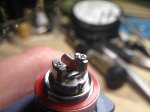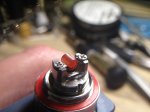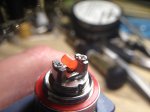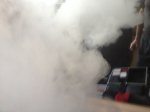LOOK AT THE STICKY VERSION OF THIS POST (OR POST 12) FOR THE NEWEST UPDATES
Hi All:
I've been seeing a ton of questions in the last few months that seem to involve new vapers who have ended up with advanced setups they're not entirely sure how to use, mechanical mods in particular. What I'm hoping to do here is start a kind of first-stop post, with links to some threads where our members have taken quite a bit of time to type out thoughtful, detailed posts answering some of the questions that get asked quite a bit. With luck it'll save some time for those of us who've already dedicated countless hours helping out...
Are these batteries good? Plus other battery info...
Some quick and dirty info: the best known 18650 batteries (the most common size for vape use) currently in production as of this post are rated for a 20 amp continuous draw - favorites in the vaping community are the Samsung 25R and LG HE2 and HE4. Sony used to make a popular 20 amp cell, the VTC5, and equally popular 30 amp cells (the only batteries that currently exist with a continuous amp rating higher than 20) called the VTC3 and VTC4 - these batteries are no longer in production, and a significant portion of those sold today are counterfeit. Even reputable sources have been known to be duped by a wholesaler somewhere along the supply chain, so exercise caution if you buy Sony.
Some companies sell batteries they didn't produce - Efest and MXJO are popular examples. These batteries will often have a misleading amp rating, claiming 35 amps when in reality what's being stated is a "pulse" or "burst" rating that can only be achieved for a short time. The continuous rating is what most experienced vapers will rely on when calculating what kind of coil they can safely use. For this reason, these batteries are not recommended as highly as trusted manufacturers such as Samsung and LG. A simple rule of thumb is to avoid any type of battery with "fire" in the name (Trustfire, Singfire, Truefire, etc.) in order to avoid setting yourself on fire.
If you're using a mech, you should never let your batteries drop below a 3.6-3.7 volt charge – draining your batteries too low can cause serious and permanent damage. Experienced vapers will know by "feel" when to change batteries, but if you don't a multimeter is a good tool to have – install a fresh battery (which should be charged to 4.2 volts), take a dozen or so pulls on your mod, then pull the battery out and test it. Repeat this process until your battery is down to 3.7 volts, then put it on the charger and install a new one. After practicing this for a few days, you'll develop the feel needed to stay safe and can stop monitoring constantly. Instructions on using a multimeter:
http://altsmoke.com/multimeter.html
Getting a decent battery charger should also be high on your priority list – the three most popular for vape use, listed in descending order of general quality perception, are Xtar, Efest (even though the batteries aren't recommended), and Nitecore. If you must cheap out in other areas, don't when it comes to your batteries or charger.
What kind of mod should I buy?
If you're asking this question, you should probably be looking at a regulated device – these allow you to adjust power settings and have safety functions built in so the device won't fire if you've accidentally done something dangerous. With the massive proliferation of regulated mods on the market, some offering massive power well in excess of 100 watts, there's really not much to be gained from using a mechanical mod with no circuitry or safety features. This wasn't the case as late as a year ago, when regulated devices were severely limited in power output and the only way to get big power was to build yourself.
With advanced regulated devices, there are two sub-categories: self-contained and replaceable battery. The self-contained units are nice for their small size and for alleviating the need to buy separate batteries and a charger, but they're also limited in power output as compared to replaceable battery mods. Also, if you have a battery problem your whole mod is pretty much junk - with replaceable batteries you can toss them (actually, please recycle them in a proper fashion) and get new ones for a few dollars when they wear out.
That said, if you're set on a mechanical, or "mech," there are two main types – those with a 510 pin between your atomizer and the battery, and "hybrid" models with a hole in the top cap, allowing your battery to contact the atomizer directly. These are desirable because they produce less voltage drop (power loss), but dangerous because if the center pin of your atomizer doesn't protrude from the bottom of the threads and stay firmly locked in place the battery could contact the threads, causing a hard short that will in turn cause your battery to vent and/or explode in short order. For this reason, hybrids generally aren't recommended as a first mech.
What kind of atomizer should I buy?
This is a highly subjective question. Let's assume there are three main types, RDAs (Rebuildable Dripping Atomizers), RTAs (Rebuildable Tank Atomizers), and clearomizers, which have factory-built, replaceable coils.
There is an insanely wide variety of RDA and RTA choices available, and new devices hit the market at a rate of several per week. Some are built to maximize flavor, others for big clouds, some strike a balance between the two. You'll have to do your own research on the forums to see what appeals to you, as simply asking this question is likely to net a slew of answers wherein members tell you what they've experienced and liked, but very few of us have experience with enough different devices to speak with authority on others with which we're not familiar. Those that do have that experience are probably posting reviews to help you with your research, rather than waiting for you to post a thread asking them to deliver a dissertation on the 100 devices they're personally familiar with.
More helpful: do some research, and if you narrow your search down to 2 or 3 devices, that's the time to start a thread asking for specific comparisons between them. You'll still get a lot of posts from people that either ignore your question or are such fanboys of their favorite devices that they'll try to tell you that you need to buy whatever they have because if they bought something it must be the best, but having some idea of what you want before posting will help reduce these usually-unhelpful comments, or at least limit them to suggestions that closely align with what you want if you've worded your desires clearly.
Clearomizers, long adored for their simplicity and shunned for their lack of power and "sick clouds bro" abilities, are making a huge comeback in 2015 with the advent of the "sub-tank" segment of the market that uses low-resistance coils. Again, there are a ton of these on the market, each with its fans and detractors, so you'll have to do your own research for the most part. One thing to note is that many of these do not have a sufficiently-protruding center pin for use on hybrid mechs, so it's strongly recommended to avoid combining the two.
A helpful thread with lots of info and reviews of sub-tanks collected in one place:
http://www.vapingunderground.com/threads/subtank-wars.60527/
What kind of wire/coil should I use to get sick clouds, bro?
If you haven't built a coil before, it may be best to start small – a single coil with a resistance in the 1.0 ohm range. To get this you're going to need some thin gauge wire, like 28. You'll probably move on to more advanced builds once you have a few successful smaller ones, so it would be a good idea to pick up a variety of round Kanthal, say in gauges of 28, 26, and 24, to start. Wire is cheap and can be had for around $5 a spool. Don't worry if you move on before you use up all your thin wire, it'll come in handy if you start learning advanced builds that involve wrapping or braiding multiple strands down the line.
YOU NEED TO HAVE A MEANS OF CHECKING YOUR COIL RESISTANCE BEFORE ATTEMPTING TO USE IT. To repeat, YOU NEED TO HAVE A MEANS OF CHECKING YOUR COIL RESISTANCE BEFORE ATTEMPTING TO USE IT. Ohm meters are available for around $15 and are very simple to use, not to mention handy building platforms to keep your atomizer in place while you install your coils. You can also use a multimeter, which is handy to have if you're using a mech and need to test your batteries as well. Instructions on using one for vaping purposes can be found here:
http://altsmoke.com/multimeter.html
I find that I can get great flavor and vapor production out of simple dual coil builds using the tension coil method @MacTechVpr goes into detail on throughout this thread (and there's even more over at ECF if you're inclined to visit that forum and search):
http://www.vapingunderground.com/threads/micro-coil-frustration.3692/#post-76476
Of course, there are tons of other great options, depending on how complex and intricate you want your builds to get – check out the Builders Corner subforums for more, but for basics it's probably best to stick to round Kanthal and avoid the exotic builds/wire materials/ribbon wires/etc.
Helpful calculators and assistance with planning your builds can be found at:
http://www.steam-engine.org/
A good thread on how to effectively wick your coils from @scarecrowjenkins (he's using Japanese cotton, but the fundamentals are sound for regular cotton and rayon, too):
http://vapingunderground.com/threads/rda-wicking-method-w-japanese-cotton.64969/
See Post 10 below for a continuation, including links to other helpful threads...
Hi All:
I've been seeing a ton of questions in the last few months that seem to involve new vapers who have ended up with advanced setups they're not entirely sure how to use, mechanical mods in particular. What I'm hoping to do here is start a kind of first-stop post, with links to some threads where our members have taken quite a bit of time to type out thoughtful, detailed posts answering some of the questions that get asked quite a bit. With luck it'll save some time for those of us who've already dedicated countless hours helping out...
Are these batteries good? Plus other battery info...
Some quick and dirty info: the best known 18650 batteries (the most common size for vape use) currently in production as of this post are rated for a 20 amp continuous draw - favorites in the vaping community are the Samsung 25R and LG HE2 and HE4. Sony used to make a popular 20 amp cell, the VTC5, and equally popular 30 amp cells (the only batteries that currently exist with a continuous amp rating higher than 20) called the VTC3 and VTC4 - these batteries are no longer in production, and a significant portion of those sold today are counterfeit. Even reputable sources have been known to be duped by a wholesaler somewhere along the supply chain, so exercise caution if you buy Sony.
Some companies sell batteries they didn't produce - Efest and MXJO are popular examples. These batteries will often have a misleading amp rating, claiming 35 amps when in reality what's being stated is a "pulse" or "burst" rating that can only be achieved for a short time. The continuous rating is what most experienced vapers will rely on when calculating what kind of coil they can safely use. For this reason, these batteries are not recommended as highly as trusted manufacturers such as Samsung and LG. A simple rule of thumb is to avoid any type of battery with "fire" in the name (Trustfire, Singfire, Truefire, etc.) in order to avoid setting yourself on fire.
If you're using a mech, you should never let your batteries drop below a 3.6-3.7 volt charge – draining your batteries too low can cause serious and permanent damage. Experienced vapers will know by "feel" when to change batteries, but if you don't a multimeter is a good tool to have – install a fresh battery (which should be charged to 4.2 volts), take a dozen or so pulls on your mod, then pull the battery out and test it. Repeat this process until your battery is down to 3.7 volts, then put it on the charger and install a new one. After practicing this for a few days, you'll develop the feel needed to stay safe and can stop monitoring constantly. Instructions on using a multimeter:
http://altsmoke.com/multimeter.html
Getting a decent battery charger should also be high on your priority list – the three most popular for vape use, listed in descending order of general quality perception, are Xtar, Efest (even though the batteries aren't recommended), and Nitecore. If you must cheap out in other areas, don't when it comes to your batteries or charger.
What kind of mod should I buy?
If you're asking this question, you should probably be looking at a regulated device – these allow you to adjust power settings and have safety functions built in so the device won't fire if you've accidentally done something dangerous. With the massive proliferation of regulated mods on the market, some offering massive power well in excess of 100 watts, there's really not much to be gained from using a mechanical mod with no circuitry or safety features. This wasn't the case as late as a year ago, when regulated devices were severely limited in power output and the only way to get big power was to build yourself.
With advanced regulated devices, there are two sub-categories: self-contained and replaceable battery. The self-contained units are nice for their small size and for alleviating the need to buy separate batteries and a charger, but they're also limited in power output as compared to replaceable battery mods. Also, if you have a battery problem your whole mod is pretty much junk - with replaceable batteries you can toss them (actually, please recycle them in a proper fashion) and get new ones for a few dollars when they wear out.
That said, if you're set on a mechanical, or "mech," there are two main types – those with a 510 pin between your atomizer and the battery, and "hybrid" models with a hole in the top cap, allowing your battery to contact the atomizer directly. These are desirable because they produce less voltage drop (power loss), but dangerous because if the center pin of your atomizer doesn't protrude from the bottom of the threads and stay firmly locked in place the battery could contact the threads, causing a hard short that will in turn cause your battery to vent and/or explode in short order. For this reason, hybrids generally aren't recommended as a first mech.
What kind of atomizer should I buy?
This is a highly subjective question. Let's assume there are three main types, RDAs (Rebuildable Dripping Atomizers), RTAs (Rebuildable Tank Atomizers), and clearomizers, which have factory-built, replaceable coils.
There is an insanely wide variety of RDA and RTA choices available, and new devices hit the market at a rate of several per week. Some are built to maximize flavor, others for big clouds, some strike a balance between the two. You'll have to do your own research on the forums to see what appeals to you, as simply asking this question is likely to net a slew of answers wherein members tell you what they've experienced and liked, but very few of us have experience with enough different devices to speak with authority on others with which we're not familiar. Those that do have that experience are probably posting reviews to help you with your research, rather than waiting for you to post a thread asking them to deliver a dissertation on the 100 devices they're personally familiar with.
More helpful: do some research, and if you narrow your search down to 2 or 3 devices, that's the time to start a thread asking for specific comparisons between them. You'll still get a lot of posts from people that either ignore your question or are such fanboys of their favorite devices that they'll try to tell you that you need to buy whatever they have because if they bought something it must be the best, but having some idea of what you want before posting will help reduce these usually-unhelpful comments, or at least limit them to suggestions that closely align with what you want if you've worded your desires clearly.
Clearomizers, long adored for their simplicity and shunned for their lack of power and "sick clouds bro" abilities, are making a huge comeback in 2015 with the advent of the "sub-tank" segment of the market that uses low-resistance coils. Again, there are a ton of these on the market, each with its fans and detractors, so you'll have to do your own research for the most part. One thing to note is that many of these do not have a sufficiently-protruding center pin for use on hybrid mechs, so it's strongly recommended to avoid combining the two.
A helpful thread with lots of info and reviews of sub-tanks collected in one place:
http://www.vapingunderground.com/threads/subtank-wars.60527/
What kind of wire/coil should I use to get sick clouds, bro?
If you haven't built a coil before, it may be best to start small – a single coil with a resistance in the 1.0 ohm range. To get this you're going to need some thin gauge wire, like 28. You'll probably move on to more advanced builds once you have a few successful smaller ones, so it would be a good idea to pick up a variety of round Kanthal, say in gauges of 28, 26, and 24, to start. Wire is cheap and can be had for around $5 a spool. Don't worry if you move on before you use up all your thin wire, it'll come in handy if you start learning advanced builds that involve wrapping or braiding multiple strands down the line.
YOU NEED TO HAVE A MEANS OF CHECKING YOUR COIL RESISTANCE BEFORE ATTEMPTING TO USE IT. To repeat, YOU NEED TO HAVE A MEANS OF CHECKING YOUR COIL RESISTANCE BEFORE ATTEMPTING TO USE IT. Ohm meters are available for around $15 and are very simple to use, not to mention handy building platforms to keep your atomizer in place while you install your coils. You can also use a multimeter, which is handy to have if you're using a mech and need to test your batteries as well. Instructions on using one for vaping purposes can be found here:
http://altsmoke.com/multimeter.html
I find that I can get great flavor and vapor production out of simple dual coil builds using the tension coil method @MacTechVpr goes into detail on throughout this thread (and there's even more over at ECF if you're inclined to visit that forum and search):
http://www.vapingunderground.com/threads/micro-coil-frustration.3692/#post-76476
Of course, there are tons of other great options, depending on how complex and intricate you want your builds to get – check out the Builders Corner subforums for more, but for basics it's probably best to stick to round Kanthal and avoid the exotic builds/wire materials/ribbon wires/etc.
Helpful calculators and assistance with planning your builds can be found at:
http://www.steam-engine.org/
A good thread on how to effectively wick your coils from @scarecrowjenkins (he's using Japanese cotton, but the fundamentals are sound for regular cotton and rayon, too):
http://vapingunderground.com/threads/rda-wicking-method-w-japanese-cotton.64969/
See Post 10 below for a continuation, including links to other helpful threads...
Last edited:





